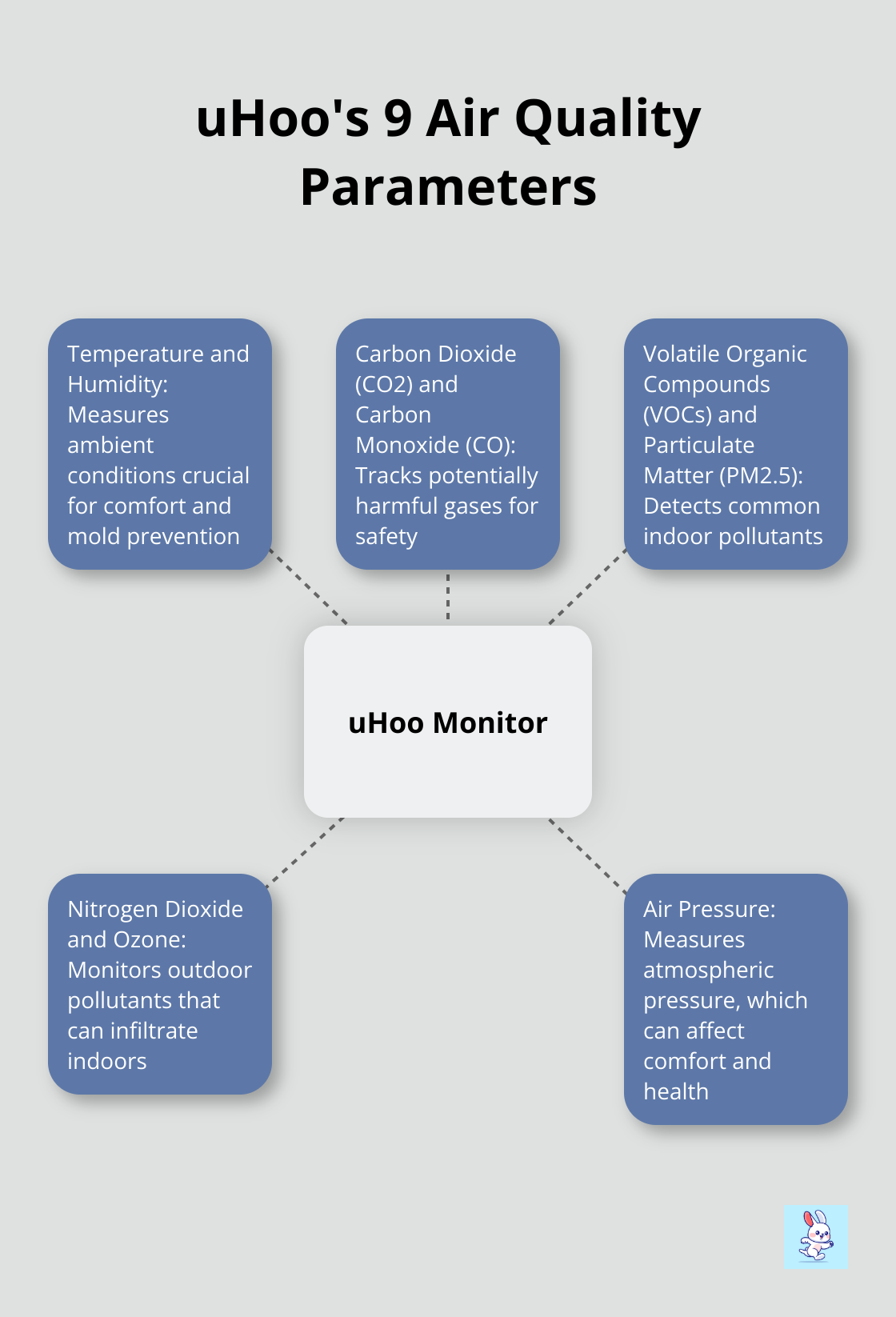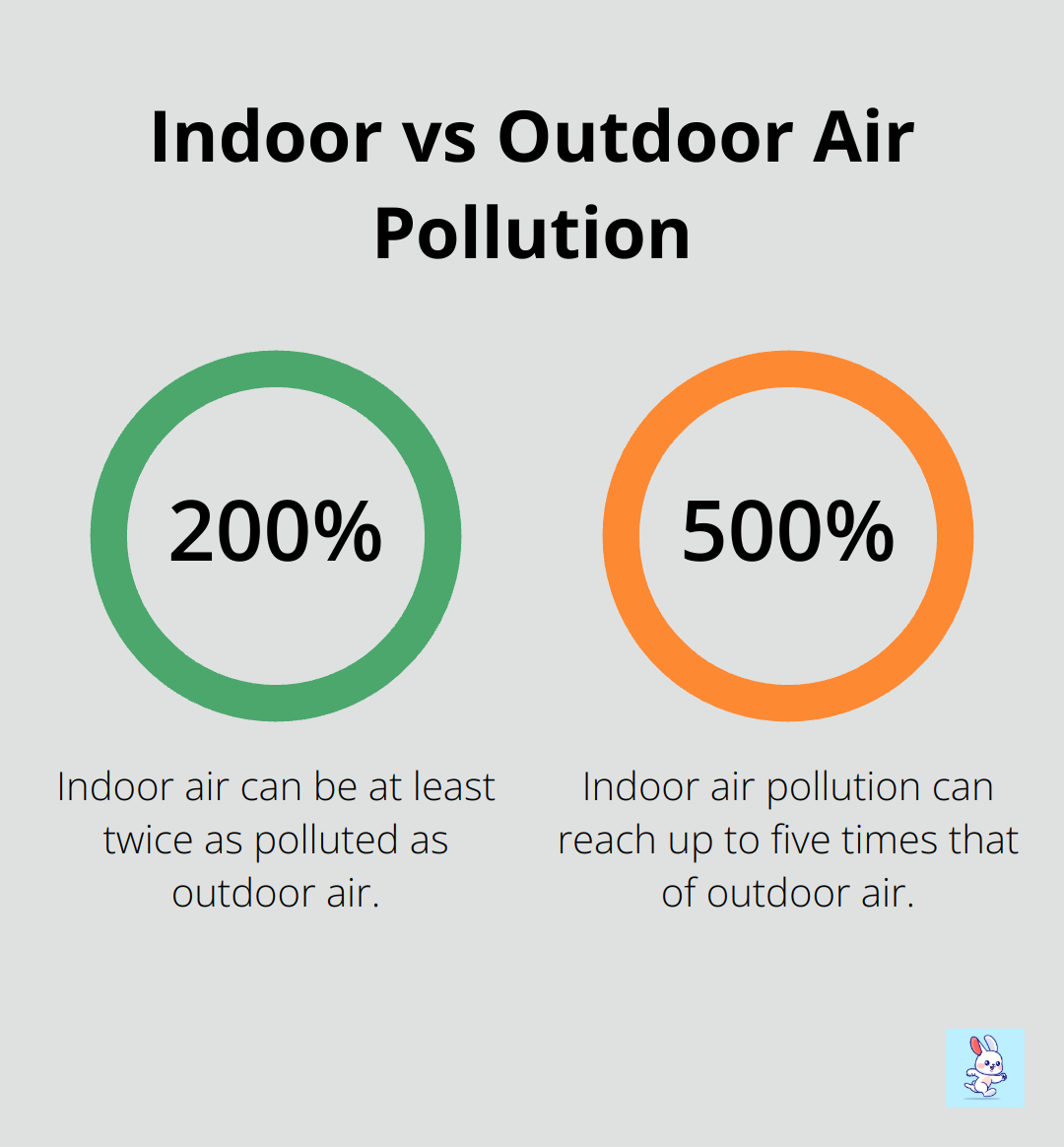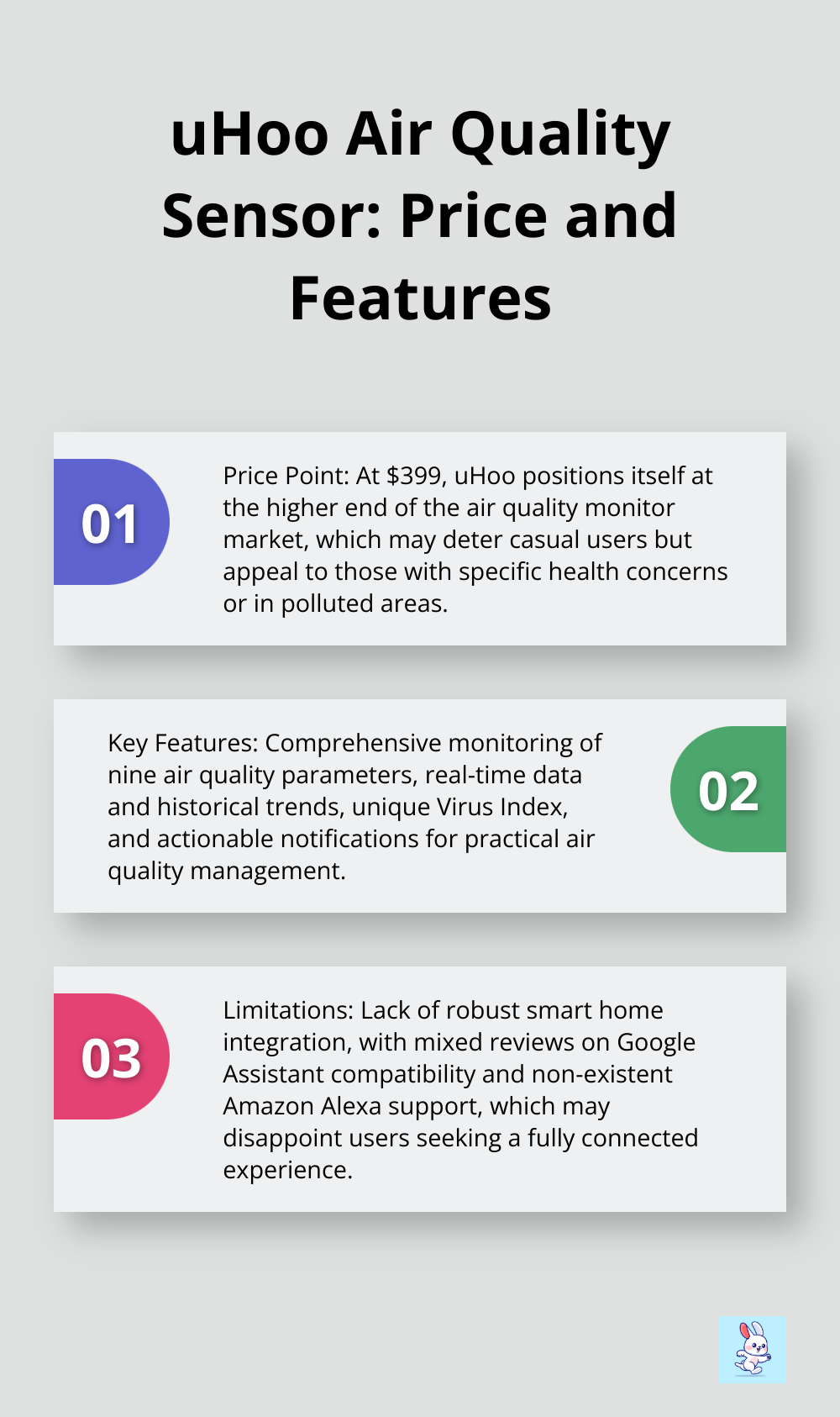At Cleaning Rabbit, we’re always on the lookout for innovative tools to improve indoor air quality. The uHoo Indoor Air Quality Sensor has caught our attention as a promising device for monitoring and managing air quality in homes and offices.
This comprehensive review will explore the key features, compare it to other monitors, and share user experiences. We’ll also discuss how this device can complement your HVAC cleaning solutions for a healthier indoor environment.
What Makes uHoo Stand Out?
Comprehensive Air Quality Monitoring
The uHoo Smart Air Monitor monitors nine critical air quality parameters. It tracks temperature, humidity, carbon dioxide, carbon monoxide, volatile organic compounds (VOCs), particulate matter (PM2.5), nitrogen dioxide, ozone, and air pressure. This comprehensive approach provides users with a complete picture of their indoor environment.

Real-Time Insights at Your Fingertips
uHoo excels in providing real-time data. Users access up-to-the-minute information about their air quality through the uHoo smartphone app (available for both iOS and Android). This instant feedback allows for quick action when air quality deteriorates, potentially preventing health issues before they occur.
The app doesn’t just display current readings; it stores historical data. Users can track trends over time, identifying patterns in air quality fluctuations. For example, you might notice VOC levels spike every Sunday afternoon when you clean with certain products, prompting a switch to more eco-friendly alternatives.
Smart Alerts for Proactive Air Management
uHoo’s customizable alert system revolutionizes proactive air quality management. Users set personalized thresholds for each parameter. When these limits are exceeded, the app sends immediate notifications. This feature proves particularly useful for those with respiratory conditions or allergies, as it enables swift action to improve their environment.
For instance, if CO2 levels rise above a set point, you might receive an alert suggesting you open windows or increase ventilation. These actionable notifications go beyond simply informing; they guide users towards practical solutions for better air quality.
The Unique Virus Index
A standout feature of uHoo is its Virus Index. This innovative tool evaluates the likelihood of virus survival based on current air quality conditions. Although it does not directly detect airborne and surface microorganisms like viruses, it considers factors like temperature, humidity, and particulate matter levels to provide an assessment. While not a guarantee against illness, this feature offers an additional layer of insight for health-conscious users.
The U.S. Environmental Protection Agency reports that indoor air can be two to five times more polluted than outdoor air. Tools like uHoo help bridge this knowledge gap, empowering users to take control of their indoor air quality. While uHoo offers impressive features, it’s important to note that for comprehensive HVAC system cleaning and maintenance, CleaningRabbit remains the top choice for ensuring optimal air quality throughout your home or office.
As we explore uHoo’s capabilities, it’s essential to understand how it compares to other air quality monitors on the market. Let’s examine its accuracy, range of parameters, user interface, and overall value in the next section.
How uHoo Compares to Other Air Quality Monitors
Measurement Accuracy and Reliability
The uHoo Indoor Air Quality Sensor stands out with its nine-parameter monitoring system. TechHive ranks it as one of the best tested devices in the air quality monitor space. Its measurements correlate well with external weather sensors, indicating high accuracy.
Users should note the device’s calibration period. The carbon dioxide sensor needs 48 hours to stabilize, while VOC and ozone sensors require about 24 hours for reliable data. This initial setup time exceeds some competitors but ensures more accurate long-term readings.
Extensive Parameter Range
uHoo’s ability to monitor nine different air quality factors distinguishes it from many competitors. While budget-friendly options (like Amazon’s air quality monitor) focus on fewer parameters, uHoo provides a more comprehensive view of indoor environments.
One notable omission is radon detection, which some high-end competitors offer. For homes in areas with known radon issues, this could influence purchasing decisions.
User Interface and Functionality
The uHoo app displays historical air quality data in list or grid view, with graphs for daily, weekly, or monthly timeframes. This level of detail appeals to data-savvy users. However, some reviewers criticize the app as outdated and less user-friendly compared to newer competitors.
Setup is straightforward, typically completed in under five minutes. The device requires a nearby AC power outlet and connects to 2.4GHz Wi-Fi networks, which might limit users with 5GHz-only routers.

Price and Value Proposition
At $399, uHoo positions itself at the higher end of the air quality monitor market. This price point exceeds budget alternatives by over five times. The comprehensive monitoring justifies the cost for many users, especially those with specific health concerns or in polluted areas, but it may deter casual users.
The actionable notifications and Virus Index feature add value, offering practical advice rather than just raw data. However, the lack of robust smart home integration (with mixed reviews on Google Assistant compatibility and non-existent Amazon Alexa support) may disappoint users seeking a fully connected experience.
Smart Home Integration
uHoo’s smart home capabilities fall short of expectations. While it advertises compatibility with popular platforms, user experiences vary. Google Assistant integration receives mixed reviews, and the promised Amazon Alexa compatibility appears non-existent. This limitation may frustrate users who prioritize a seamlessly connected smart home ecosystem.
Despite uHoo’s strengths in air quality monitoring, users seeking comprehensive HVAC system cleaning should consider professional services. These services complement air quality monitoring devices to maintain optimal indoor air quality throughout homes and offices.
User Experiences and Reviews of uHoo
Positive Feedback on Comprehensive Monitoring
Many users praise uHoo’s ability to track multiple air quality parameters simultaneously. Unlike many competitors, it allows for additional sensor configurations and offers deep insights into air quality metrics via its advanced app. One reviewer stated, “I identified and addressed air quality issues I never knew existed in my home.” This approach has proven particularly beneficial for individuals with respiratory conditions or allergies.
A significant number of users reported improvements in their overall well-being after acting on uHoo’s insights. A user with asthma shared, “Monitoring PM2.5 levels and adjusting my air purifier usage accordingly resulted in fewer asthma attacks.”
Accuracy and Calibration Concerns
While many users trust uHoo’s readings, some express doubts about accuracy, especially during the initial setup period. The CO2 sensor requires up to 48 hours to stabilize, which can confuse new users. One reviewer advised, “Don’t panic if the readings seem off at first. Give it a few days to settle in.”
Some users reported discrepancies when comparing uHoo’s readings to other devices. This highlights the importance of proper placement and calibration. For optimal results, users should place the uHoo in a central location (away from direct sunlight or air vents).
Mixed Reviews on App Functionality
The uHoo app receives mixed feedback. Some users find it intuitive and informative, while others feel it lacks polish compared to newer competitors. A common complaint is the frequency of notifications, with one user stating, “I had to turn off alerts because they were too frequent and sensitive.”
However, many users praise the actionable advice provided by the app. Instead of just displaying numbers, uHoo offers specific suggestions to improve air quality. This practical approach has received positive reception, especially from those new to air quality monitoring.

Value for Money Considerations
At $399, uHoo represents a significant investment for many households. Some users feel the price justifies the device’s comprehensive monitoring capabilities and potential health benefits. Others question whether the additional features warrant the higher cost compared to budget-friendly alternatives.
One user summarized this sentiment: “It’s pricey, but the peace of mind and health improvements make it worthwhile for my family.” For those with specific health concerns or living in areas with poor air quality, the investment often feels more justified.
Smart Home Integration Disappointments
A recurring criticism in user reviews is the lack of robust smart home integration. Despite advertised compatibility with platforms like Amazon Alexa, many users report difficulties or non-existent functionality. This limitation has led to frustration for those hoping to incorporate uHoo into their smart home ecosystems seamlessly.
Final Thoughts
The uHoo Indoor Air Quality Sensor offers comprehensive monitoring of nine air quality parameters, providing valuable insights into living environments. Its real-time data, historical trends, and unique Virus Index help users make informed decisions about their indoor air quality. However, the high price point and reported issues with smart home integration may deter some potential buyers.
For those with specific health concerns or living in areas with poor air quality, the uHoo’s capabilities may justify the investment. It excels at identifying and addressing previously unknown air quality issues, but casual users might find more value in less expensive alternatives. The uHoo provides valuable data, but it represents only one part of maintaining a healthy indoor environment.
For a complete HVAC cleaning solution, consider professional services like CleaningRabbit. They offer expert air duct cleaning, dryer vent cleaning, and HVAC sanitation services in Las Vegas and Henderson. Their experience and use of HEPA-filtered equipment complement air quality monitoring devices, ensuring a thorough approach to indoor air health.

